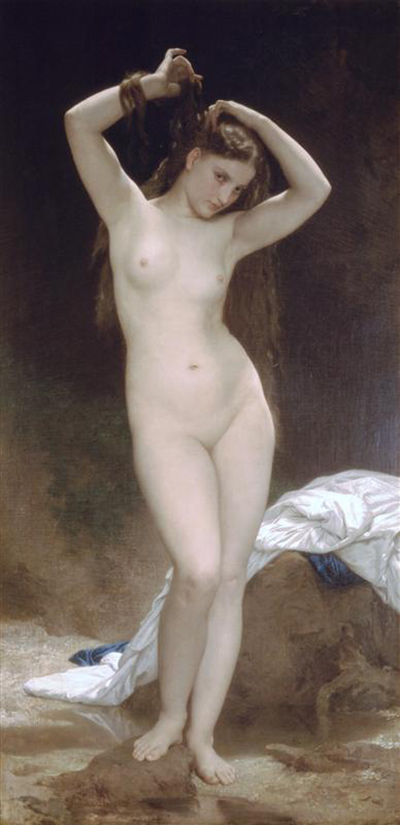Currently part of the collection of the Museo Teatro Salvador Dali, “Baigneuse” was painted by the French nineteenth century Salon artist William-Adolphe Bouguereau (1825-1905) in 1870.
Bouguereau was one of the leading, most successful, artists of his age.
In 1850 he entered the coveted Prix de Rome and won a three-year scholarship to the Villa Medici, in Rome, where, in addition to more formal training, he was able to study the masterpieces of Renaissance art as well as the Greek, Etruscan and Roman works of antiquity.
On his return to France, in 1854, he embarked on a hugely successful and influential career as a traditional academic artist exhibiting his work at the Paris Salon throughout his working life.
An industrious, skilful and prolific painter he produced numerous portraits of an almost photographic quality, paintings with mythological and religious themes, and nudes that managed to be classical in their inspiration while being imbued with a coy eroticism.
“Baigneuse” is one such painting. It portrays a young nude woman seemingly putting up her hair before entering the rock pool at her feet to bathe.
Her clothes are laid across a rock behind her. With her arms raised above her head her graceful pose is reminiscent of a sculpture of ancient Greece or Rome. Bouguereau captures the softness of the woman's skin, the anatomical perfection of her young body and the calm, confident, almost challenging, expression on her face, to perfection.
It is that confident challenging expression, that appears to be aimed directly at the viewer of the painting, that gives it its power and impact and lifts its eroticism above the merely salacious.
Bouguereau was a master of the female nude and it is clear that his work appealed to a wide audience, in France and abroad, during his lifetime.
His approach to art, however, was soon considered overly conservative and supplanted by the impressionists and later art movements. After his death his reputation fell steeply and his paintings were no longer admired but were seen as vacuous and vulgar.
It is only in recent times that his work has begun to be re-evaluated and his paintings appreciated once more.




